Pacific Beach, San Diego
Pacific Beach is a neighborhood in San Diego, bounded by La Jolla to the north, Mission Beach and Mission Bay to the south, Interstate 5 to the east and the Pacific Ocean to the west.[1] While formerly largely populated by young people, surfers, and college students, because of rising property and rental costs the population is gradually becoming older and more affluent.[2] "P.B.," as it is known as by local residents, is home to one of San Diego's more developed nightlife scenes, with a great variety of bars, eateries, and clothing stores located along Garnet Avenue and Mission Boulevard.
Pacific Beach, San Diego | |
|---|---|
| Pacific Beach | |
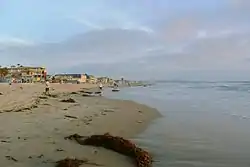 The beach at Pacific Beach looking south | |
| Nickname(s): "P.B." | |
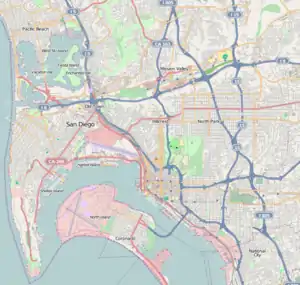 Pacific Beach, San Diego Location within Central San Diego | |
| Coordinates: 32.7978265°N 117.2403142°W | |
| Country | |
| State | |
| County | |
| City | |
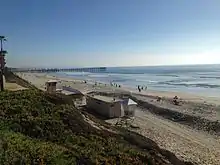
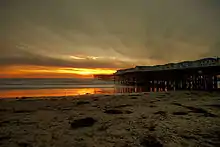

The beach
Pacific Beach's namesake stretches for miles from the Mission Bay jetty to the cliffs of La Jolla. The boardwalk, officially called Ocean Front Walk/Ocean Boulevard, is a pedestrian walkway that runs approximately 3.2 miles along the beach from the end of Law St. in the north down into Mission Beach, ending at the mouth of Mission Bay in the south. There are numerous local shops, bars, hotels, and restaurants along the boardwalk, and it is generally crowded with pedestrians, cyclists, rollerbladers, skateboarder and shoppers. Adjacent to the boardwalk is the Crystal Pier, a public pier and hotel at the west end of Garnet Avenue. San Diego City Council banned the use of all electric-motor scooters in December of 2019.[3]
Streets
The streets in Pacific Beach were renamed several times before receiving their current designations in 1900.[4][5] The primary north-south street running parallel to the beach is Mission Blvd., with the streets named after late 19th century federal officials, then incrementing in alphabetical order as they move further from the coast: Bayard, Cass, Dawes, Everts, Fanuel, Gresham, Haines, Ingraham, Jewell, Kendall, Lamont, Morrell, Noyes, Olney, Pendleton, Quincy, Randall, and San Joaquin. Mission Boulevard was formerly Allison Street, being the "A" street of the series. Ingraham was initially named Broadway (1887), then was changed to Izard (1900), back to Broadway (1907) and finally settled as Ingraham Street in 1913.[5]
The east-west streets are mostly named after precious stones. Starting at the north end of Mission Blvd. and heading south, the streets are:
- Agate
- Turquoise
- Sapphire
- Tourmaline - see Tourmaline Surfing Park
- Opal
- Loring
- Wilbur
- Beryl
- Law
- Chalcedony
- Missouri
- Diamond
- Emerald
- Felspar - an alternate spelling of "Feldspar" that has fallen out of use
- Garnet - pronounced locally with the second syllable accented, /ɡɑːrˈnɛt/, unlike the pronunciation of the stone
- Hornblend - spelled differently from the mineral hornblende
- Grand
- Thomas
- Reed
- Oliver
- Pacific Beach Drive
History

Before European-contact, the area was settled by the Kumeyaay people, who built a large village then known as Hamo, or Jamo, on the banks of Rose Creek at the entrance of Rose Canyon.
As with many California cities, the history of San Diego's development can be traced back to the completion of a cross-country railroad in 1885.[5] The town developed during the boom years between 1886 and 1888 by D. C. Reed, A. G. Gassen, Charles W. Pauley, R. A. Thomas, and O. S. Hubbell. It was Hubbell who "cleared away the grainfields, pitched a tent, mapped out the lots, hired an auctioneer and started to work".[4] A railway connected Pacific Beach with downtown San Diego starting in 1889, and was extended to La Jolla in 1894.[5]
Early landmarks and attractions in Pacific Beach included an asbestos factory (established in 1888), a race track, and the San Diego College of Letters (1887-1891), none of which survive today.[6][5] At the turn of the century, lemon growing and packing dominated the local economy.[5] In 1910, the San Diego Army and Navy Academy, a preparatory school, was established in an old College building; in 1922 a public high school followed and a junior high in 1930.[5] In 1927, Crystal Pier opened; the Roxy Movie theater opened in 1943 to cater to a population that grew five times during World War II.[5] The postwar period saw the establishment of many hotels: the Bahia (1953), the Catamaran (1959), and Vacation Village (1965).[5] High rise construction in nearby Mission Bay led to the establishment of a 30 foot height limitation for buildings in 1972, an ordinance still in effect.[5] Prominent boardwalk Ocean Avenue was closed in 1982 and became a park.[5]
In 1902, lots sold for between $350–700 for oceanfront property. By 1950, the population of Pacific Beach reached 30,000 and the average home sold for $12,000.[7] Nonetheless, a small number of farms remained. Today, homes can sell for millions.
The United States Navy operated an anti-aircraft training center at Pacific Beach during World War II.[8] During the 1960s, development continued to increase with the city's investment in Mission Bay Park, including the developments of the Islandia, Vacation Village and Hilton Hotels. In 1964 Sea World opened, which is located only a few miles from Pacific Beach.
The original name of this feature was "Bay Point" and today one may still find a USGS bench mark and associated RM (DC1025, DC1026 respectively) with that name there.[9] The "Bay Point Formation" is the name of a local rock strata first found and described there.[10]
Today, Pacific Beach is home to a younger crowd, including college students, single professionals, and families. The restaurant and nightlife culture has grown extensively, with Garnet Avenue becoming the major hub for places to eat, drink, and shop, and includes a range of bars, restaurants, pubs, and coffee houses.
Education
Pacific Beach public schools are part of the San Diego Unified School District. They include Mission Bay Senior High School, Pacific Beach Middle School, Pacific Beach Elementary, Kate Sessions Elementary, Barnard Elementary, and Crown Point Junior Music Academy .
Parks

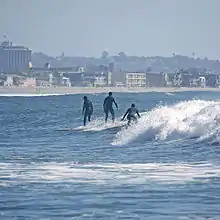
In addition to bordering the Pacific Ocean and Mission Bay Park, Pacific Beach includes Kate Sessions Park and the Pacific Beach Recreation Center. Kate Sessions Park has a playground, large lawn with ocean views, and a many acre unmaintained area used for hiking and mountain biking. Fanuel Street Park is a popular bay-front park with playground equipment suitable for toddler and school-age children. Rose Creek, which flows through Pacific Beach before emptying into Mission Bay, provides open space and a rich wetland area.
Organizations
The nonprofit Pacific Beach Town Council promotes the area and organizes community events.[11] The Pacific Beach Planning Group advises the city on land use and other issues.[12] The Pacific Beach and Mission Bay Visitor Center provides information on the Pacific Beach Town Council, special events, lodging, dining, and Pacific Beach history.[7] Service clubs include Kiwanis, Rotary, Lions Club, Girl Scouts, Pacific Beach Woman's Club,[13] Surf Club, Friends of the PB Library, PB Garden Club, and Toastmasters.
Media
Pacific Beach is serviced in print by the daily San Diego Union Tribune and the weekly Beach & Bay Press.
Bars and nightlife
Pacific Beach is one of the main centers of nightlife in San Diego. Garnet Avenue, between Ingraham Street and Mission Boulevard, is where many bars and restaurants are located. The nightlife in Pacific Beach caters to a younger crowd than the nightlife in downtown San Diego.
In literature
In John Dos Passos's The 42nd Parallel (1930), Fainy "Mac" McCreary briefly lives in a bungalow in Pacific Beach with his wife Maisie and their daughter Rose.
Notable people
- Kate Sessions, Landscape Architect
- Frank Bompensiero, mobster
- Donna Frye, former city council representative and mayoral candidate
- Skip Frye, professional surfer
- Adam Gnade, musician-novelist
- Tony Gwynn, Jr., former outfielder in the MLB
- Robert Hays, actor, known for role in Airplane
- Pauly Shore, actor, former MTV host
- Eddie Vedder, musician
- Dinesh D’Souza, political commentator
- Vic Fuentes, musician
- Mark Whitney Mehran Owner of Hotrodsurf
See also
- Tourmaline Surfing Park at the north end of Pacific Beach
- List of beaches in San Diego County
- List of California state parks
| To the North: Tourmaline Surfing Park |
California beaches | To the South Mission Beach, San Diego |
References
| Wikivoyage has a travel guide for Mission Beach & Pacific Beach. |
| Wikimedia Commons has media related to Pacific Beach. |
- "Community Profiles Pacific Beach - City of San Diego Official Website". www.sandiego.gov. Retrieved 15 April 2018.
- "Pacific Beach". www.sandiego.com. Retrieved 2018-02-09.
- "San Diego bans e-scooters along the boardwalk from Mission Beach to La Jolla". Retrieved 3 March 2020.
- "Locker, Z.B., "Whatever happened to Izard Street?" Journal of San Diego History, 1976". sandiegohistory.org. Retrieved 15 April 2018.
- Fry, John (1987). A Short History of Pacific Beach. Pacific Beach: John Fry Productions.
- Fetzer, Leland (2005). San Diego County Place Names A to Z. San Diego: Sunbelt Publications. p. 108.
In 1869, the site of the district's first race track, Agricultural Park ... promoters founded Pacific Beach Subdivision in 1887. Here they erected the San Diego College of Letters ... When it failed, its buildings became the Hotel Balboa.
- Pacific Beach and Mission Bay Visitor Center Archived 2013-01-05 at Archive.today
- "U.S. Naval Activities World War II by State". Patrick Clancey. Retrieved 2012-03-19.
- http://www.ngs.noaa.gov/cgi-bin/datasheet.prl
- Valentine, James William (1 July 1959). "The Bay Point Formation at its type locality (Calif), (Part) 1 of Pleistocene molluscan notes". Journal of Paleontology. 33 (4): 685–688. Retrieved 15 April 2018 – via jpaleontol.geoscienceworld.org.
- "Pacific Beach Town Council". www.pbtowncouncil.org. Retrieved 15 April 2018.
- "Pacific Beach Planning Group - City of San Diego Official Website". www.sandiego.gov. Retrieved 15 April 2018.
- "Pacific Beach Woman's Club". www.pbwomansclub.org. Retrieved 1 January 2021.
| To the North: La Jolla |
California beaches | To the South Mission Beach |